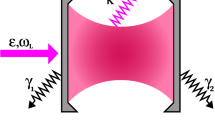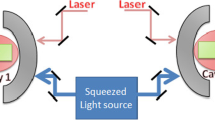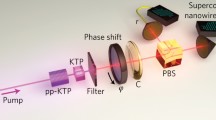Abstract
In this work, we study an entanglement concentration scheme in a 3-mode optomechanical system. The scheme is based on phonon counting measurements, which can be performed through photon counting of an auxiliary cavity connected to the mechanical resonator. The amount of entanglement between the two cavity output modes is found to increase logarithmically with the number of detected phonons (photons). Such an entanglement concentration scheme is deterministic since, independently of the number of detected phonons (photons), the measurement always leads to an increase in output entanglement. Besides numerical simulations, we provide analytical results and physical insight for the improved entanglement and the concentration efficiency.
Similar content being viewed by others
References
Molmer K, Sorensen A.Multiparticle entanglement of hot trapped ions. Phys Rev Lett, 1999, 82: 1835–1838
You J Q, Tsai J S, Nori F. Controllable manipulation and entanglement of macroscopic quantum states in coupled charge qubits. Phys Rev B, 2003, 68: 024510
Wang Y D, Chesi S, Loss D, et al. One-step multiqubit Greenberger-Horne-Zeilinger state generation in a circuit QED system. Phys Rev B, 2010, 81: 104524
Aspelmeyer M, Kippenberg T J, Marquardt F. Cavity optomechanics. Rev Mod Phys, 2014, 86: 1391–1452
Wang Y D, Clerk A A. Using interference for high fidelity quantum state transfer in optomechanics. Phys Rev Lett, 2012, 108: 153603
Tian L. Adiabatic state conversion and pulse transmission in optomechanical systems. Phys Rev Lett, 2012, 108: 153604
Wang Y D, Clerk A A. Using dark modes for high-fidelity optomechanical quantum state transfer. New J Phys, 2012, 14: 105010
Wang Y D, Clerk A A. Reservoir-engineered entanglement in optomechanical systems. Phys Rev Lett, 2013, 110: 253601
Barzanjeh S, Abdi M, Milburn G, et al. Reversible optical-tomicrowave quantum interface. Phys Rev Lett, 2012, 109: 130503
Tian L. Robust photon entanglement via quantum interference in optomechanical interfaces. Phys Rev Lett, 2013, 110: 233602
Kuzyk M C, van Enk S J, Wang H. Generating robust optical entanglement in weakcoupling optomechanical systems. Phys Rev A, 2013, 88: 062341
Wang Y D, Chesi S, Clerk A A. Bipartite and tripartite output entanglement in three-mode optomechanical systems. Phys Rev A, 2015, 91: 013807
Andrews R, Peterson R W, Purdy T P, et al. Bidirectional and efficient conversion between microwave and optical light. Nat Phys, 2014, 10: 321–326
Bennett C H, Brassard G, Popescu S, et al. Purification of noisy entanglement and faithful teleportation via noisy channels. Phys Rev Lett, 1996, 76: 722–725
Deutsch D, Ekert A, Jozsa R, et al. Quantum privacy amplification and the security of quantum cryptography over noisy channels. Phys Rev Lett, 1996, 77: 2818–2821
Sheng Y B, Liu J, Zhao S Y. Multipartite entanglement concentration for nitrogen-vacancy center and microtoroidal resonator system. Chin Sci Bull, 2014, 59(28–29): 3507–3513
Duan L M, Giedke G, Cirac J I, et al. Entanglement purification of gaussian continuous variable quantum states. Phys Rev Lett, 2000, 84: 4002–4005
Eisert J, Scheel S, Plenio MB. Distilling Gaussian states with Gaussian operations is impossible. Phys Rev Lett, 2002, 89: 137903
Kitagawa A, Takeoka M, Sasaki M, et al. Entanglement evaluation of non-Gaussian states generated by photon subtraction from squeezed states. Phys Rev A, 2006, 73: 042310
Opatrn’y T, Kurizki G, Welsch D G. Improvement on teleportation of continuous variables by photon subtraction via conditional measurement. Phys Rev A, 2000, 61: 032302
Cochrane P T, Ralph T C, Milburn G J. Teleportation improvement by conditional measurements on the two-mode squeezed vacuum. Phys Rev A, 2002, 65: 062306
Browne D E, Eisert J, Scheel S, et al. Driving non-Gaussian to Gaussian states with linear optics. Phys Rev A, 2003, 67: 062320
Maimaiti W, Mancini S. Efficiency of entanglement concentration by photon subtraction. Physica Scripta, 2014: 014028
Gardiner C, Zoller P. Quantum Noise. 3rd ed. New York: Springer, 2004
Teufel J D, Li D, Allman M S, et al. Circuit cavity electromechanics in the strong-coupling regime. Nature, 2011, 471: 204–208
Chan J, Alegre T P M, Safavi-Naeini A H, et al. Laser cooling of a nanomechanical oscillator into its quantum ground state. Nature, 2011, 478: 89–92
DeJesus E X, Kaufman C. Routh-Hurwitz criterion in the examination of eigenvalues of a system of nonlinear ordinary diffierential equations. Phys Rev A, 1987, 35: 5288–5290
Giedke G, Kraus B, Lewenstein M, et al. Separability properties of three-mode Gaussian states. Phys Rev A, 2001, 64: 052303
van Loock P, Braunstein S L. Multipartite entanglement for continuous variables: A quantum teleportation network. Phys Rev Lett, 2000, 84: 3482–3485
Eichenfield M, Chan J, Camacho R M, et al. Optomechanical crystals. Nature, 2009, 461: 78–82
Safavi-Naeini A H, Painter O. Proposal for an optomechanical traveling wave phonon-photon translator. New J Phys, 2011, 13: 013017
Vidal G, Werner R F. Computable measure of entanglement. Phys Rev A, 2002, 65: 032314
Author information
Authors and Affiliations
Corresponding author
Rights and permissions
About this article
Cite this article
Maimaiti, W., Li, Z., Chesi, S. et al. Entanglement concentration with strong projective measurement in an optomechanical system. Sci. China Phys. Mech. Astron. 58, 1–6 (2015). https://doi.org/10.1007/s11433-015-5657-8
Received:
Accepted:
Published:
Issue Date:
DOI: https://doi.org/10.1007/s11433-015-5657-8




